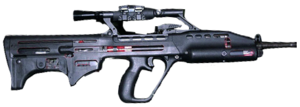| SAR 21 | |
|---|---|
 SAR 21, right side view. Pictured SAR 21 is attached with the Round Corner Firing (RCF) module and has had its magazine removed. | |
| Type | Bullpup assault rifle |
| Place of origin | Singapore |
| Service history | |
| In service | 1999–present[1] |
| Used by | See Users |
| Production history | |
| Designer | Tuck Wah Chee and Felix Tsai of Chartered Industries of Singapore/ST Kinetics[2] |
| Designed | 1996[1] |
| Manufacturer | • CIS: 1999–2000[1] • ST Kinetics: 2000–present[1] |
| Produced | 1999–present[1] |
| Variants | See variants |
| Specifications | |
| Mass | • SAR 21: 4 kg (8.82 lb)[1] • SAR 21 GL/M203: 5.3 kg (12 lb) • SAR 21 P-Rail: 3.6 kg (7.9 lb) • SAR 21 MMS: 3.5 kg (7.7 lb) • SAR 21 Light Weight Carbine 3 kg (6.6 lb) |
| Length | 805 mm (31.7 in) (SAR 21, SAR 21 40 GL/M203, SAR 21 P-Rail) 680 mm (26.8 in) (SAR 21 MMS) 640 mm (25.2 in) (SAR 21 Light Weight Carbine) |
| Barrel length | 508 mm (20.0 in)[1] |
| Cartridge | 5.56×45mm NATO[1] |
| Caliber | 5.56 mm (0.22 in)[1] |
| Barrels | Single barrel 1:12" and 1:7" twist options [3] |
| Action | Gas-operated, rotating bolt |
| Rate of fire | 450–650 rounds/min[1] |
| Muzzle velocity | 970 m/s (3,182 ft/s) (M193) 945 m/s (3,100.4 ft/s) (SS109) |
| Effective firing range | 460 m (M193) 800 m (SS109) |
| Feed system | 30-round detachable plastic box magazine Export models: STANAG magazines[3] |
| Sights | 1.5x or 3x optical sight; back-up iron sights |
The SAR 21 ("Singapore Assault Rifle - 21st Century") is a bullpup assault rifle designed and manufactured in Singapore, chambered for the 5.56x45mm cartridge. First revealed and subsequently adopted by the Singapore Armed Forces (SAF) as its standard service weapon in 1999, it was designed and developed over a four-year period to replace the locally license-built M16S1[3] by the Ministry of Defence (MINDEF), Singapore Army and the former Chartered Industries of Singapore (CIS), presently ST Engineering Land Systems.[4]
Many of its design features are directly intended to address the weaknesses of the M16S1 as encountered operationally by some infantrymen.[1] The rifle is being sold for export use aside from domestic use.[5] In the United States, it was marketed by ST Kinetics via its American subsidiary, VT Systems.[6]
- ^ a b c d e f g h i j k Richard J, 2008.
- ^ "United States Patent Chee et a." Retrieved 24 July 2010.
- ^ a b c "SAR 21 Product Brochure" (PDF). ST Engineering. Archived from the original (PDF) on 4 November 2013. Retrieved 24 July 2010.
- ^ "Factsheet - Singapore Assault Rifle 21". Singaporean Ministry of Defence (MINDEF). Archived from the original on 25 December 2012. Retrieved 24 July 2010.
- ^ "Infantry Article Index". 19 November 1999. Archived from the original on 22 February 2012. Retrieved 24 July 2010.
- ^ "Call to arms in Singapore yields explosive results". Fairfax Digital. 3 August 2003. Archived from the original on 5 January 2010. Retrieved 24 July 2010.